The correct angle of sharpening a kitchen knife
The edge of any knife dulls during prolonged use. And it doesn’t matter if it is a kitchen product, hunting or fighting. To restore the instrument to its former efficiency, you need to sharpen the blade correctly. This work is carried out independently, using a simple abrasive bar. To accurately withstand the angle of sharpening a kitchen knife, a special tool is required.
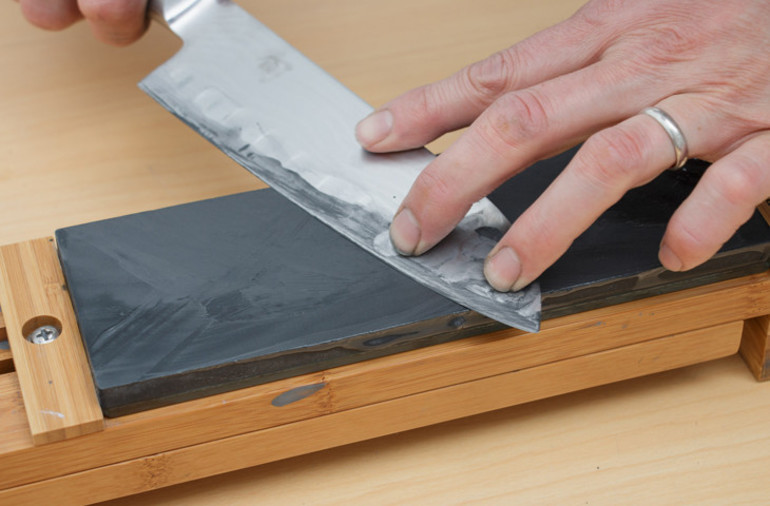
Key factors for quick wear
For the manufacture of blades using a material of different quality. For example, inexpensive models wear out during operation, as they are made of steel that undergoes optimal heat treatment beforehand. The main factors affecting the bluntness of the blade:
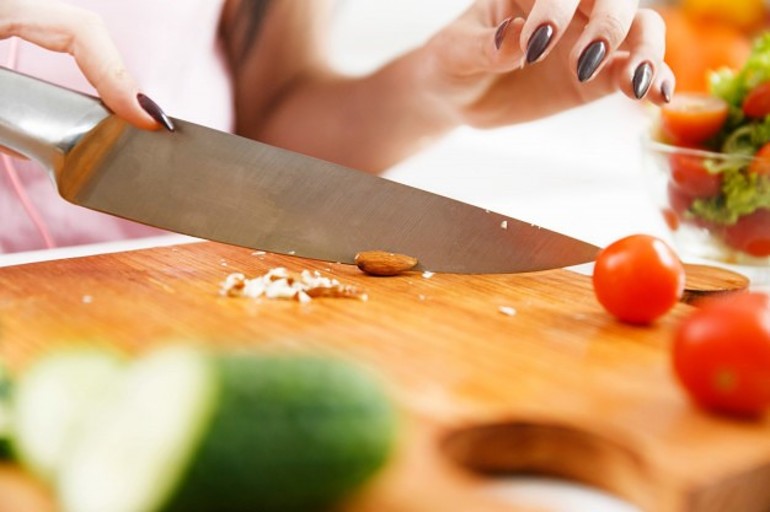
- Bad storage. Hitting a hard object, the blade of a knife becomes dull, sometimes microscopic chips appear on it. This happens when the tool is stored with metal cutlery. To avoid damage, the knives should be stored in special table stands, which are sold complete with them or on magnetic holders.
- Solid cutting board. Currently, most housewives prefer to use plastic boards, because they are easier to wash. But solid material causes the knife edge to become dull ahead of time. The same situation is with glass and stone boards. They are beautiful, easy to use and hygienic, only because of them the blade deteriorates instantly. The best option is considered to be boards made of wood. During the cutting process, the knife tip rounds more slowly.
- Fish bones and scales. It is impossible to chop and cut fish bones with a universal knife, as this adversely affects the sharpness of the blade. The blade may also suffer from dense fish scales. Butchering fish is best done with tools specifically designed for such work.
- Dirty vegetables. The cutting part of the knife suffers from the remnants of the earth, small pebbles that are in unwashed products. They act on the blade like sandpaper, blunting it. Therefore, all products should be thoroughly washed before slicing.
Knife device
To maintain the correct angle of knife sharpening for the kitchen, you need to know the design features of the blade. The standard model consists of 5 parts:
- fifth - this part is located near the junction of the handle with the blade and is not sharpened;
- point - the junction of the blade with the butt;
- descent - a slightly narrowed area located near the sharpened edge of the blade;
- butt - the widest part of the knife, located in the upper zone;
- the cutting edge is the blade.
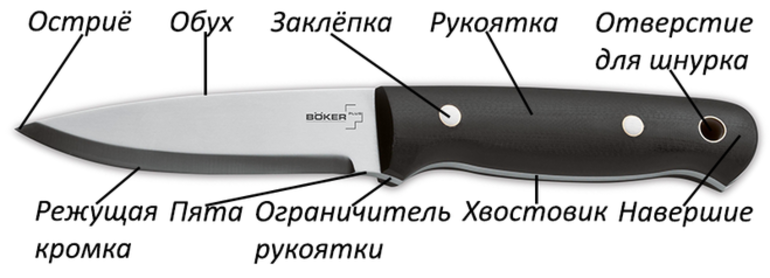
Sharpening angle depending on the model
Most users do not know at what angle to sharpen a kitchen knife. But comfort and safety of its use depend on this parameter. The table shows examples of standard parameters for the angle of sharpening, which varies depending on the type of knife.
| Knife type | Angle, in degrees |
| Canteens | 55−60 |
| Tourist - for cutting meat and fish | 40−45 |
| Tourist - for soft products | 30−35 |
| For fruits and vegetables | 35 |
| Professional cooks (chef - knives) | 25 |
| Scalpels | 15 |
| Boning | 25−30 |
| Loin | 10−15 |
| Pen | 20−30 |
| Folding hunting, for sanding | 40−45 |
| Shoemaker, saddlery | 30−40 |
| Chopping hatchet, cleaver | 40−45 |
| Household kitchen, round | 30−35 |
The smaller the sharpening angle, the sharper the blade, but it is very susceptible to damage. If the angle is obtuse, the quality of the cut worsens, but the tool is highly resistant to solid objects.
Determination methods
The starting angle may not match the recommended or standard settings. To accurately calculate at what angle to sharpen kitchen knives, you can use some methods. The most common ones are:
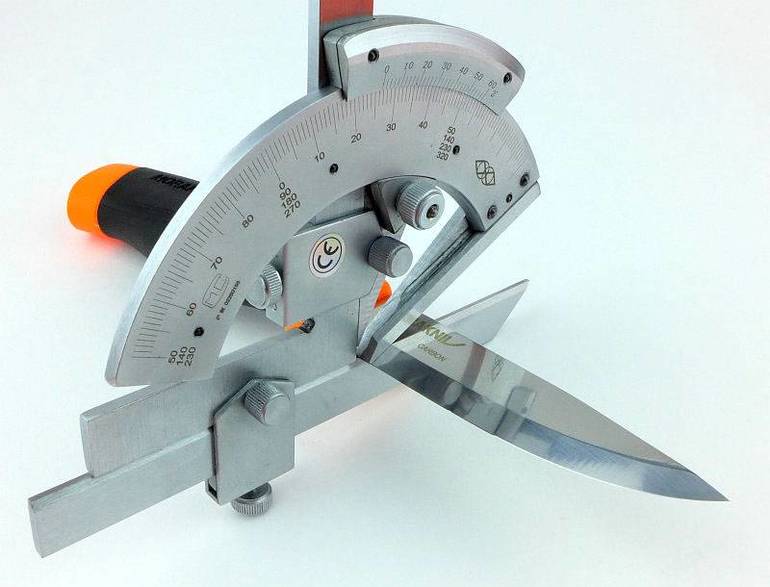
- Scissors and protractor. The sharpened section of the tool must be installed across the scissor blades. The angle that is formed between the blades is the necessary parameter. It is he who needs to be measured by a protractor.
- Board and paraffin. Paraffin is melted and applied to the edge of the board, pre-lubricating this area with oil. After that, a knife is stuck into it and held until the paraffin hardens. The blade is carefully removed and a photo is taken of this site. To measure the angle, just enlarge the image.
- The ruler is a square. First, the measurement is done as with scissors, then the tools are applied to the paper and circled with a pencil. Between the lines that formed in the figure, lay a ruler and make a measurement.
The easiest and most ideal way to accurately know the angle is to use a goniometer.
Grinding tool selection
In theory, knife sharpening is a simple job, but not everyone can do it professionally. There are several tools designed for this work, each of which has its own functions. The most modern and popular devices:
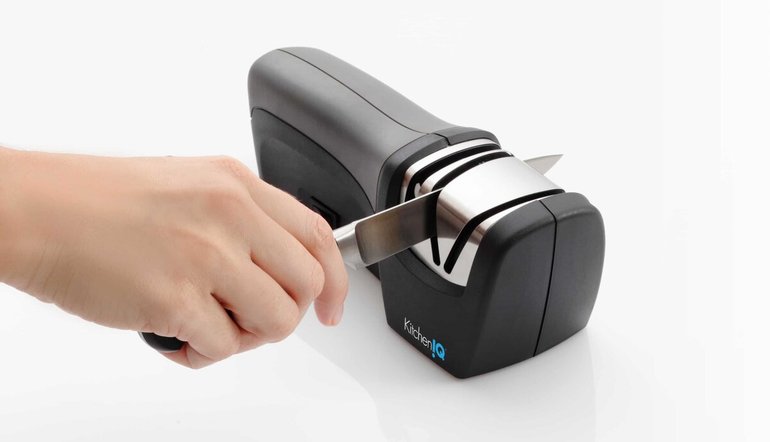
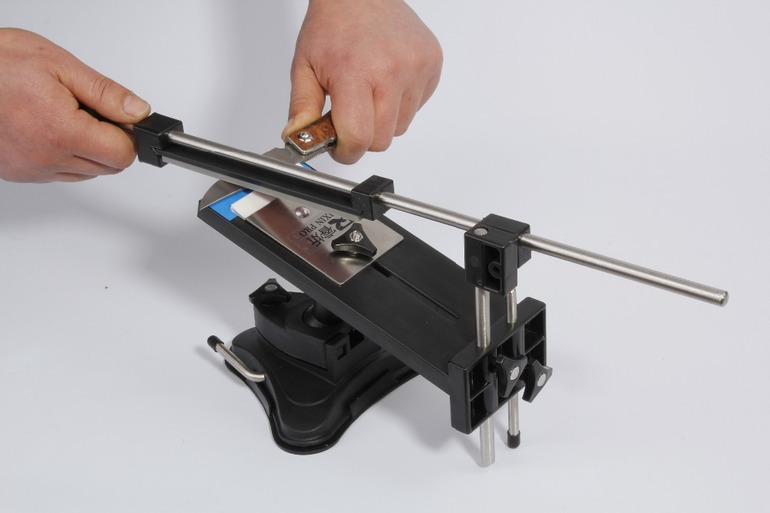
- Electric sharpener. It is a functional, versatile tool with diamond blades. Which circle to sharpen depends on the type of blade. Thanks to several holes, you can not only sharpen it, but also grind it, carry out fine-tuning. The tool is simple and safe to use.
- Mechanical tool. Sharpener refers to hand tools. In the protective case of the device there are 2 disks, thanks to which work is carried out. To do this, put the blade between the discs, then stretch from the heel to the tip. Such actions will make the cutting edge sharper. If the knife is moved uniformly without jerking, it will be sharpened evenly. In this case, you can not increase the pressure, it should be the same along the entire length.
- Whetstone The tool has 3 stones: with a fine-grained degree of abrasiveness, medium and rough. First, the cutting edge of the knife is sharpened on a larger abrasive stone, then gradually move to small. Such a smooth transition will allow better processing. To prevent the pores of the device from clogging with metal particles, during operation, the surface of the stone should be moistened with water.
- Musat. Externally, the device resembles a file. The tool can be made of ceramic, steel or diamond. For home use, choose a model up to 25 cm long.
- A set of tools for sharpening. The set includes bars of different grain sizes, fixing clamps and oil. With this device, it is easy to control the sharpening angle of a kitchen knife.
- Sharpening machine. This is a high-quality and convenient machine related to professional appliances. If there is no experience with such a machine, the knife blade can be easily broken.
Before you purchase a grinder, you must carefully study its characteristics. A store consultant can tell you which tool to choose.
Japanese Product Processing
Japanese kitchen knife differs from other products with one-sided sharpening of the blade. While in most of them, the blade is symmetrical. The outer side of the cutting edge has an inlet, which consists of three connected planes. And its other side is slightly concave. The sharpening angle of Japanese kitchen knives can vary from 15 to 40 °, depending on its purpose. In order to sharpen such a tool, it is necessary to strictly observe the grinding angle and pressure force, therefore only a professional can perform this work. Work order:
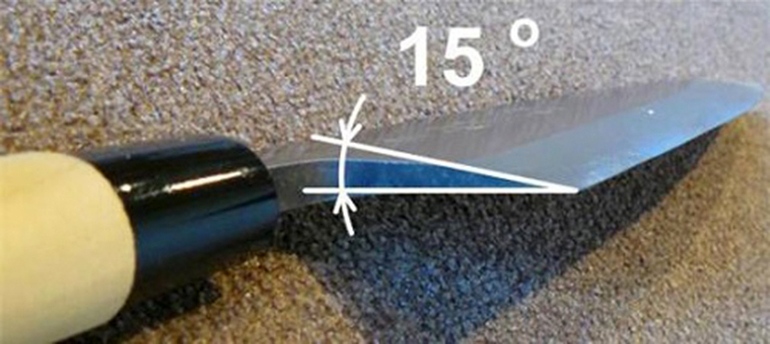
- First you need to fix minor scratches and chips.To do this, the blade is processed on a coarse-grained stone, abrasive 400-700. Special fixing clips are put on the edge. This will prevent the sharpening angle from shifting.
- After the initial treatment, you need to align the blade and give it sharpness. This stage is considered the main, the work is carried out with a stone, the abrasiveness of which is 700−2000.
- To make the edge of the knife perfectly sharp, the blade is treated with a stone with a grain size from 2 thousand to 5 thousand.
There are several nuances that must be considered when sharpening Japanese knives. Firstly, the processed edge must be clean and dry. Secondly, sharpening is carried out until all burrs and scratches have completely disappeared. Excessive stone pressure on the blade must not be allowed. Bad sharpening or not, can be determined using light. Minor scratches and damage upon careful inspection will reflect flare.
Maintaining sharpness
Each user tries to monitor their knives and keep them in good condition. But sometimes the blade wears out because the tool was improperly looked after. There are 3 types of sharpening that will help maintain sharpness or restore an already damaged blade:
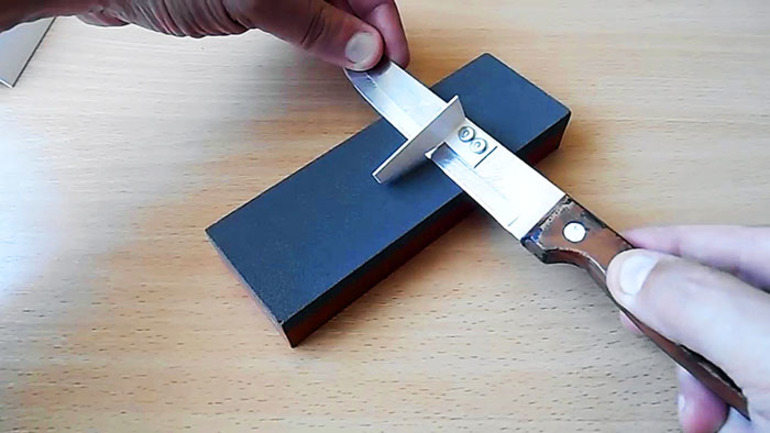
- If the edge is not severely deformed, then it must be corrected. This processing method is preventive and has nothing to do with sharpening.
- If the blade is worn enough, then it is necessary to remove several layers of metal from it. This is already considered sharpening, so the work is done with abrasive material.
- A badly damaged tool with chips and bends can be repaired by grinding the blade all the way. After the procedure, descents are made, then a new cutting edge is created. By the same principle, new knives are made from blanks. If the product is cheap, do not rebuild it, as this is a very expensive process. It is used only for expensive, high-quality knives.
If you systematically edit the product, and also perform sharpening when the cutting properties of the tool are reduced, then you do not have to deal with a complete restoration of the blade.
To cook with pleasure, kitchen appliances must be well sharpened. You can sharpen an instrument in various ways, and which one is the best is difficult to answer unambiguously. Only your own experience will allow you to choose the best option.
- How to choose a vacuum cleaner taking into account the characteristics of the house and coatings?
- What to look for when choosing a water delivery
- How to quickly create comfort at home - tips for housewives
- How to choose the perfect TV - useful tips
- What to look for when choosing blinds
- What should be running shoes?
- What useful things can you buy in a hardware store
- Iphone 11 pro max review
- Than iPhone is better than Android smartphones



